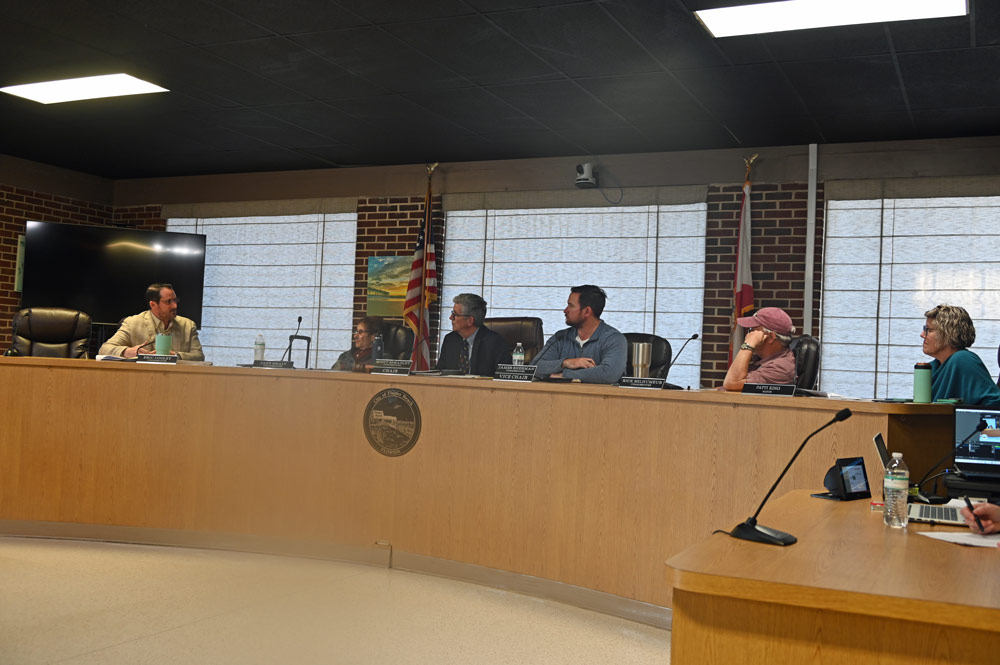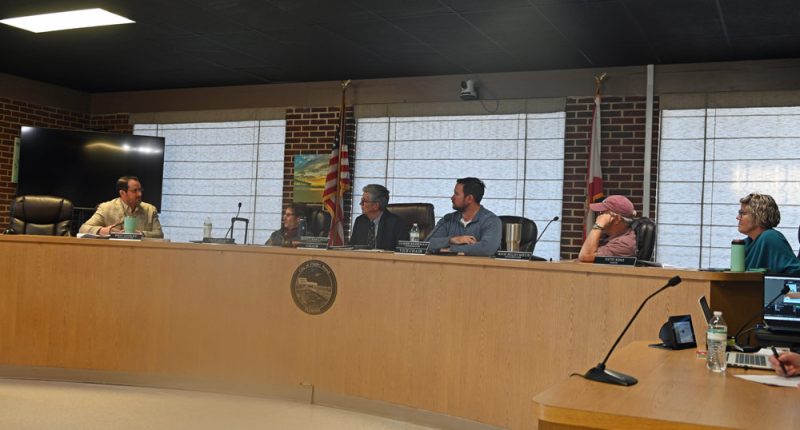
The Flagler Beach City Commission in a special workshop Thursday gave solid and unanimous backing to county government’s plan to take over preservation and management of the county’s 18 miles of beaches in perpetuity, a plan that depends on raising the sales tax by half a cent and on winning Palm Coast government’s approval.
“As far as this as a general concept, I’m all in,” Flagler Beach Commissioner Eric Cooley said, setting the tone for what was to follow in the hour-long workshop. “And the reason why is because this helps everybody. Everyone benefits, and everybody pays a very small nominal fee, versus certain groups of folks paying a disproportionate amount.” Even Palm Coast would stand to net $2.7 million in additional revenue. No one’s property taxes would go up. “I’m all in. Nuts and bolts, we can hash out,” Cooley said.
The county plan is a huge relief to Flagler Beach, which would have been incapable of generating the money necessary to manage its beaches on its own or provide the local match–at least $14 million–when the next round of beach renourishment on the 2.7 miles federalized by the Army Corps of Engineers is due in about six years. “What we’re talking about is looking for a way to fund this and it’s outside the capability of Flagler Beach to do that,” Spradley said.
The city’s endorsement follows the County Commission doing likewise on Monday (with one commissioner’s dissent), boosting the plan that County Administrator Heidi Petito and Deputy Administrator Jorge Salinas developed at the commission’s direction and have submitted to every municipality in the past two weeks. But without Palm Coast’s support, the plan dies, and with it any future hope that the recently completed Army Corps of Engineer renourishment project will continue, let alone expand. Beaches in the unincorporated parts of the barrier island might get renourished, but in staccato segments that defeat the purpose of uniform beach management.
The $114 million plan combines a variety of sources to fund beach reconstruction (or renourishment) and management over the next six years: grants, county property tax revenue, tourist tax revenue, and a $160 fee levied on every property on the barrier island. A critical part of the plan is the proposed increase of the local sales tax to 7.5 percent (from 7 percent), which would generate $10.6 million the first year, and more after that. The county would allocate its entire share ($4.7 million) to beach management. The plan calls on Flagler Beach to turn over all its share of the revenue to beach management ($277,000), and calls on Palm Coast and Bunnell to turn over half their shares ($2.7 million from Palm Coast, $105,000 from Bunnell), leaving them the other half to add to their general revenue. (See the details: “Flagler County’s $114 Million Beach Management Plan Depends on Raising Sales Tax and Winning Cities’ Buy-In.”)
Palm Coast City Council members did not reject the plan when Petito presented it to them last week. But a majority of council members favored sending the sales tax proposal to a referendum rather than support the County Commission enacting it by a supermajority vote (as it enacted the 2012 sales tax). That would almost certainly kill the plan. The proposal would fail in a referendum, especially in a city with a poor record in that regard, the more so in a city with a council that would presumably not lend its supporting voice to the referendum. To the county and to Flagler Beach, Palm Coast’s referendum approach is a punt to defeat.
Flagler Beach commissioners did not dwell on what Palm Coast will and will not do. That will be hashed out when all local governments hold a joint meeting on the plan, their second in two months, on March 12. Flagler Beach Commission Chair Scott Spradley focused on getting clarity from each commission member and Mayor Patti King, and on understanding what questions, if any, commissioners may have had about the plan. He said Cooley’s sum-up mirrored his. Commissioners James Sherman and Rick Belhumeur said likewise. King had been concerned about the county taking over the city’s beaches until she understood that “take-over” was not quite the intent, so much as management of the sands. The city’s control of its beaches, its policing, its rules and ordinances relating to the beaches would remain in effect.
Only Commissioner Jane Mealy raised a few questions, which Petito answered: beach management funds will be held in a separate, transparent account, with oversight. And yes, beach-renourishment frequency has been reduced from every 11 years to every six, now that erosion is accelerating. That satisfied Mealy, though she said she was “a little uncomfortable with Palm Coast getting half of their money back,” meaning half the revenue from the proposed sales tax increase. “I think a lot of the property value in Palm Coast is still because of the beach, even though they’re not on the beach. I’d say the majority of my friends live in Palm Coast. They spend more time at the beach than I do, so there’s some value to that beach, whether their house is on it or not. The same with Bunnell.”
After 19 years on the commission, Mealy was defeated in this week’s election, while Commissioner James Sherman was re-elected. But that won’t change the commission’s stance. Commissioner-Elect John Cunningham was at Thursday’s meeting. He did not address the commission. But in a brief conversation with FlaglerLive following the meeting, he said he is supportive of the commission’s consensus.
While Cooley said paid parking, when it is implemented, will not be a “golden goose” for the city, R.J. Santore, a local resident proposed paid parking discounts for Palm Coast similar to those that would be offered to Flagler Beach residents could be an additional incentive for the city to lend its support to the plan. Santore–an increasingly involved resident who may be positioning himself for a commission seat–was one of just three people who spoke from a near-empty chamber during the workshop. Others in the audience included Petito and Salinas (Petito answered the commissioners’ questions) and Commission Chair Andy Dance, who did not speak.
One of the other residents spoke critically of the revenue’s oversight and the structuring of the $160 fee on barrier island properties. Another suggested balancing the $160 fee with a $25 fee per parcel in the rest of the county.
But every commissioner knew that their own or even the county’s support of the plan means nothing without Palm Coast, which gives the big city veto power over the future of the beaches. Cooley aimed his comments across the Intracoastal. “This was brought up in another meeting in the county where one of the elected said, ‘I didn’t run to raise your water bills. That’s not why we run. We run to solve problems.’” Cooley was referring to Palm Coast Council member Ty Miller, who spoke those words (in the main) as he joined a 3-1 majority this week to approve the largest water and sewer rate increase in the city’s history, to fund the largest pair f loans in its history ($455 million), all to fund critical improvements to the city’s infrastructure.
Cooley continued, “Now, if we have a problem, and that’s going to require a little bit from everybody to solve, then unfortunately we’re in the position where we have to say, look, no matter what alternatives you put on the table, this particular one is probably going to be the best one, because everything else will end up in the long run being either catastrophic or costing more money.”
![]()






